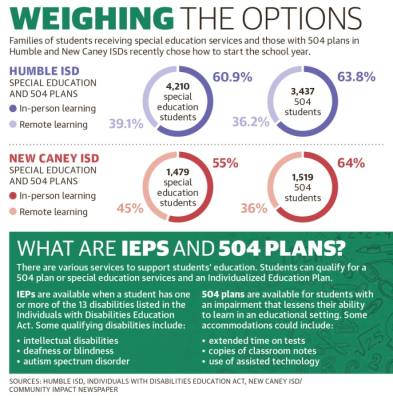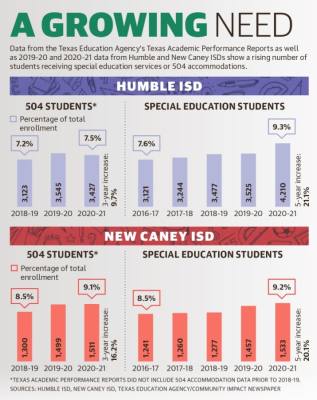Rosalba Calleros, family support coordinator at Texas Parent to Parent, said distance learning is standardized, while special education must be different for every child based on their needs. The Austin-based nonprofit supports Texas families whose children have disabilities, including 600-700 families in the Houston region.
“Distance learning [is] pretty much a standardized way of providing special education, which is not providing individualized service for every kid,” she said. “It’s bringing a lot of concerns for the families because it’s not satisfying the needs that they have.”
More than half of students receiving special education services at HISD and NCISD chose in-person instruction for the start of the 2020-21 school year, according to the districts.
Students can qualify for special education services if they have one or more of the 13 disabilities listed in the Individuals with Disabilities Education Act, which includes but is not limited to those with intellectual disabilities or autism spectrum disorder, said Henry Phipps, the chief of educational support services for HISD.
At an August HISD school board meeting, parent Sandi Reese said her son, who has special needs, cannot learn online and needs direct support.
“Every day our school doors are closed is another day of their education permanently lost and the gap further widens between them and their peers,” she said.
Phipps said teachers have not reported regression among special education students, but HISD has programs in place to assist if necessary.
“The admission, review and dismissal committee must determine on an individual basis if the student requires an instructional program that is provided beyond the regular school year,” he said.
In-person instruction
As Houston-area school districts resumed in-person instruction, some districts—such as Spring and Montgomery ISDs—allowed students receiving special education services to return earlier.
HISD allowed self-contained special education students—or those who spend most of the day in special education classrooms—to return to campuses Aug. 17. Almost 64% of those students returned in person Aug. 17, while 36% continued remotely.
Comparatively, 60.9% of all students receiving special education services and 63.8% of students receiving Section 504 services chose in-person learning. Section 504 plans are available for students with an impairment that lessens their ability to learn in an educational setting, which could include but is not limited to those with attention deficit hyperactivity disorder or dyslexia, Phipps said.
“Students, parents, teachers and campus staff have been excited to provide ... support to students in person across all campuses,” he said.
Phipps said additional social distancing guidelines in place for students who are self-contained include a limit of eight students and staff per classroom, no large group activities and recommended face coverings for students who can tolerate them.
Meanwhile, students receiving special education services in NCISD returned to campus Sept. 8 with other students. Per NCISD data, 55% of special education students and 64% of 504 students chose to be in person.
Diego Villarreal, a NCISD student with ADHD utilizing 504 services, entered his freshman year at New Caney High School on Sept. 8. Villarreal said his parents chose to send him back to campus when it became available, and being able to see his teachers and friends made a big difference.
“I miss going to school, you know,” Villarreal said. “I like to be in a learning environment ... and being home is like really close to a learning environment, but not really.”
NCISD’s on-campus instruction plan requires all students age 10 and older to wear face coverings and social distance whenever possible. But for special education students, teachers cannot always keep their distance while providing instruction.
NCISD does not have any additional guidelines in place for students receiving special education services, but Scott Powers, the district’s executive director of public relations, said via email specific services for each student are included in each student’s Individual Education Plan, or IEP.
Remote learning
Experts said bridging the digital divide and providing synchronous learning, where students interact virtually with a teacher, will help students receiving special education services succeed remotely.
Meghan Whittaker, the director of policy and advocacy at the National Center for Learning Disabilities, which supports research for learning disabilities, said via email that providing live, virtual instruction for a portion of the day is the first step to helping students succeed virtually.
“Only once we re-establish good instruction can we begin to assess where students are and begin providing more intensive supports to help them regain ground that may have been lost during this time,” she said.
Although many have returned to campus, almost 40% of HISD’s and 45% of NCISD’s special education students chose to continue remotely for the near future.
Phipps said providing 504 accommodations and services can be challenging to master remotely as well, but HISD teachers are committed to solving individual challenges to improve access for students.
“It can be challenging to provide multisensory instruction [for dyslexia intervention] in a video format,” he said. “Supplemental online programs for optional skill practice are being provided to all students in dyslexia intervention this year.”
Lori Waldrop, NCISD’s director of special education, said via email the district formed a team during the summer to develop guidelines for students receiving special education services in the 2020-21 school year. Guidelines include specifically designed instruction provided by the special education department in addition to health guidelines.
NCISD also plans to host enrichment meetings this year to provide support for parents and students, although no further details about the meetings were released by press time.
“Online and paper packet resources for specially designed instruction required by the student’s [Individual Education Plans] are provided by the special education department,” Waldrop said.
However, some parents said they find the support lacking. NCISD parent Kristina Garcia said she has three children in the district, and her middle son receives 504 accommodations.
Garcia said although her school hosted a parent orientation, officials spoke broadly and did not go into detail about what school days and classes would be like or how students should turn in assignments.
“It’s more the kids who are the ones that feel it the most because they’re the ones who have to take on all this,” she said. “This is more than, I think, any kid should have to deal with, especially at this age.”
Colleen Ferguson contributed to this report.








